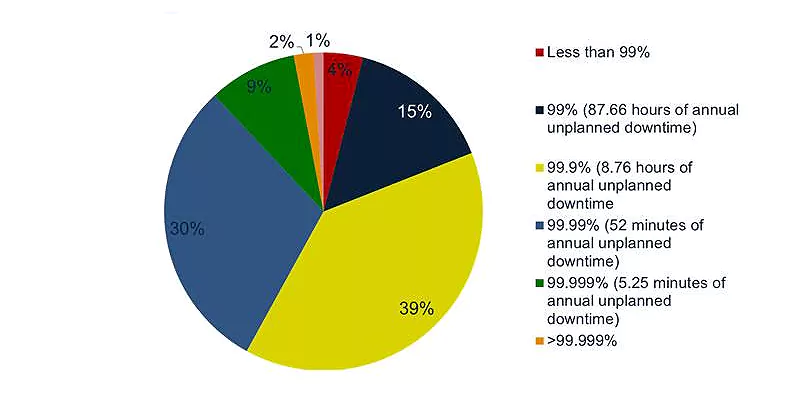Unattended website downtime in today’s age: a disaster for businesses
Website downtime can act as a major roadblock to the success of any digital business. It obstructs online operations and has a significant impact on customer satisfaction.
When a website is fully unreachable or incapable of performing its principal function for its visitors, it is said to be down. This period of outage is known as the website downtime.
This duration of outage impairs routine services, potentially resulting in productivity, income, and reputation losses. It’s an intangible disruption with real-world consequences for businesses and users alike.
The average website outage in 2023 was 1.67 hours, according to a study, indicating a modest rise from the previous year. However, the frequency of outages has dropped, with an average of 10.5 disruptions per organisation per year.
Let’s delve into the key aspects of website downtime and discover how to minimize the impact of this inevitable event on customer satisfaction.
Types of Website Downtime
Planned Downtime
This is scheduled maintenance during which the website intentionally goes offline for updates, improvements, or system upgrades.
Unplanned Downtime
This is the unexpected and often disruptive type of downtime caused by technical issues, server failures, or cyberattacks.

[Source]
Causes of Website Downtime
Here are some of the most common causes of website downtime:
Server Issues
Hardware failures or overloads on the server can lead to downtime.
Network Problems
Connectivity issues or DDoS attacks can disrupt a website’s availability.
Software Bugs
Glitches in website code can cause it to crash.
Human Error
Mistakes in configuration or updates can result in downtime.
Minimizing Website Downtime for Enhanced Customer Satisfaction:

While there is no sure shot way of completely preventing website downtime, there are ways you can minimize its frequency and the impact of website downtime on your business:
Implement Robust Hosting Solutions
Choosing a reliable hosting provider with a strong uptime record is crucial. This reduces the risk of server-related downtime.
Regular Maintenance
Plan and communicate scheduled maintenance to minimize disruption. During this time, display a friendly message to inform users of the temporary unavailability.
Automated Monitoring Tools
Utilize website downtime monitoring tools, DNS monitoring and port monitoring tools to detect issues in real-time. They can alert you to potential problems before they result in extended downtime.
Content Delivery Networks (CDNs)
CDNs distribute website content across multiple servers, reducing the load on any one server and enhancing performance and resilience.
Security Measures
Protect your website from cyberattacks by using robust security measures such as firewalls and intrusion detection systems.
Backup and Redundancy
Regularly back up your website data and maintain redundant systems to ensure swift recovery in case of failure.
Scalability
Ensure your website and hosting infrastructure can scale to handle traffic spikes without crashing. Cloud-based solutions are often scalable and reliable.
Testing and Quality Assurance
Conduct regular testing, including load testing and security testing, to identify and fix potential issues before they lead to downtime.
Communication
In case of unplanned downtime, communicate with users through social media, email, or a status page to keep them informed about the situation and expected resolution time.
Customer Support
Offer proactive customer support during downtime to address user concerns and provide assistance.
Website downtime is an unfortunate reality of the digital world, but with the right strategies and tools, its impact on customer satisfaction can be minimized.
By understanding the types and causes of downtime, implementing preventative measures, and utilizing monitoring tools like port monitoring and DNS monitoring tools, businesses can maintain a more reliable online presence.
This not only safeguards customer satisfaction but also upholds the reputation and success of your online ventures. Remember, a well-maintained website is key to keeping your customers happy and coming back for more.
Awakish- Advanced Monitoring Made Easy
Awakish offers holistic tools for ensuring the uptime of your websites and servers. You can easily maintain track of your online assets with our service and receive alerts when there are any concerns or disturbances.
Here is a gist of why you need Awakish:
Informative status Pages
Display the current status of your websites and servers to your users with our simple status pages. Custom domain names and HTTPS encryption are supported.
Monitoring Across Multiple Regions
When you subscribe to our plans, you may notice issues in as little as a few seconds from several global locations. When your server goes down, you’ll be notified right away.
SSL Certificate Expiration Notifications
With our timely warnings, you’ll never miss an SSL certificate renewal again. We send you an email 30 days before your certificate expires.
HTTP(S) Advanced Monitoring
Custom HTTP headers or payloads can be configured for monitoring requests, and response headers and payloads can be checked for comprehensive website monitoring.
And there’s more! Visit our website right away and experience advanced monitoring made easy. Get in touch.



